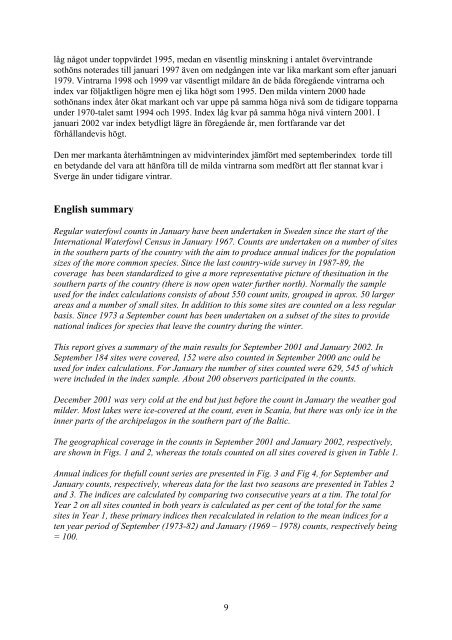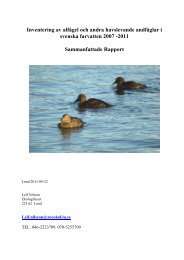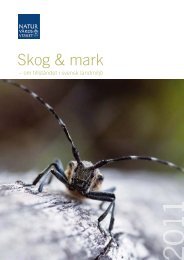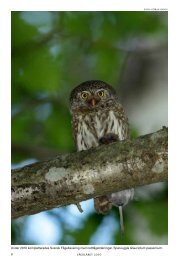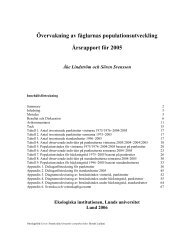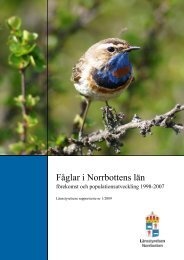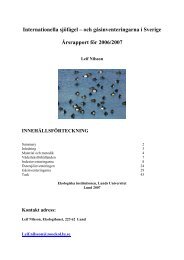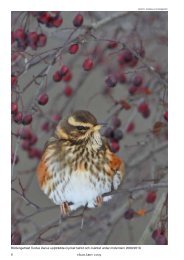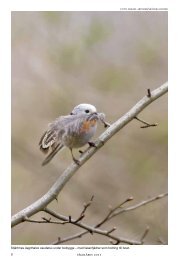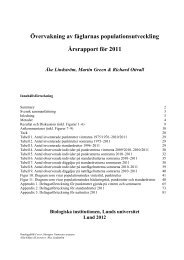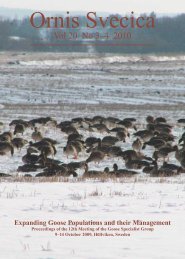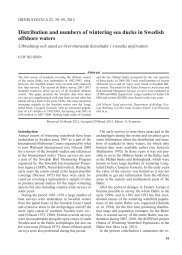Leif Nilsson - Lunds universitet
Leif Nilsson - Lunds universitet
Leif Nilsson - Lunds universitet
Create successful ePaper yourself
Turn your PDF publications into a flip-book with our unique Google optimized e-Paper software.
låg något under toppvärdet 1995, medan en väsentlig minskning i antalet övervintrande<br />
sothöns noterades till januari 1997 även om nedgången inte var lika markant som efter januari<br />
1979. Vintrarna 1998 och 1999 var väsentligt mildare än de båda föregående vintrarna och<br />
index var följaktligen högre men ej lika högt som 1995. Den milda vintern 2000 hade<br />
sothönans index åter ökat markant och var uppe på samma höga nivå som de tidigare topparna<br />
under 1970-talet samt 1994 och 1995. Index låg kvar på samma höga nivå vintern 2001. I<br />
januari 2002 var index betydligt lägre än föregående år, men fortfarande var det<br />
förhållandevis högt.<br />
Den mer markanta återhämtningen av midvinterindex jämfört med septemberindex torde till<br />
en betydande del vara att hänföra till de milda vintrarna som medfört att fler stannat kvar i<br />
Sverge än under tidigare vintrar.<br />
English summary<br />
Regular waterfowl counts in January have been undertaken in Sweden since the start of the<br />
International Waterfowl Census in January 1967. Counts are undertaken on a number of sites<br />
in the southern parts of the country with the aim to produce annual indices for the population<br />
sizes of the more common species. Since the last country-wide survey in 1987-89, the<br />
coverage has been standardized to give a more representative picture of thesituation in the<br />
southern parts of the country (there is now open water further north). Normally the sample<br />
used for the index calculations consists of about 550 count units, grouped in aprox. 50 larger<br />
areas and a number of small sites. In addition to this some sites are counted on a less regular<br />
basis. Since 1973 a September count has been undertaken on a subset of the sites to provide<br />
national indices for species that leave the country during the winter.<br />
This report gives a summary of the main results for September 2001 and January 2002. In<br />
September 184 sites were covered, 152 were also counted in September 2000 anc ould be<br />
used for index calculations. For January the number of sites counted were 629, 545 of which<br />
were included in the index sample. About 200 observers participated in the counts.<br />
December 2001 was very cold at the end but just before the count in January the weather god<br />
milder. Most lakes were ice-covered at the count, even in Scania, but there was only ice in the<br />
inner parts of the archipelagos in the southern part of the Baltic.<br />
The geographical coverage in the counts in September 2001 and January 2002, respectively,<br />
are shown in Figs. 1 and 2, whereas the totals counted on all sites covered is given in Table 1.<br />
Annual indices for thefull count series are presented in Fig. 3 and Fig 4, for September and<br />
January counts, respectively, whereas data for the last two seasons are presented in Tables 2<br />
and 3. The indices are calculated by comparing two consecutive years at a tim. The total for<br />
Year 2 on all sites counted in both years is calculated as per cent of the total for the same<br />
sites in Year 1, these primary indices then recalculated in relation to the mean indices for a<br />
ten year period of September (1973-82) and January (1969 – 1978) counts, respectively being<br />
= 100.<br />
9


